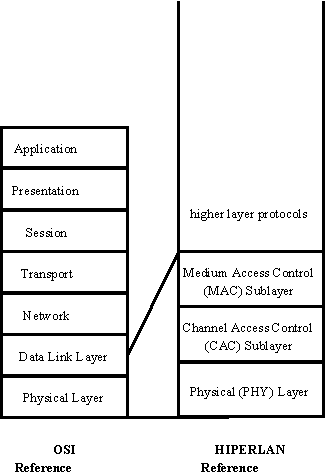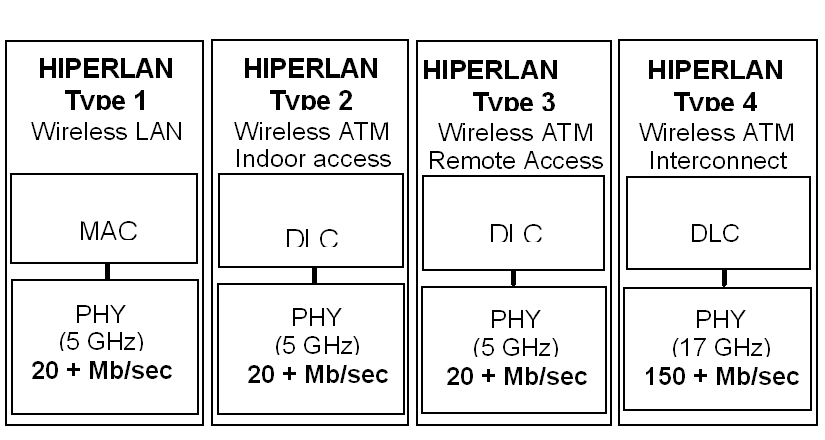
 |
JPL's Wireless Communication Reference WebsiteChapter: Network Concepts and Standards
|
HIPERLAN is a European (ETSI) standardization initiative for a HIgh PERformance wireless Local Area Network. Radio waves are used instead of a cable as a transmission medium to connect stations. Either, the radio transceiver is mounted to the movable station as an add-on and no base station has to be installed separately, or a base station is needed in addition per room. The stations may be moved during operation-pauses or even become mobile. The max. data rate for the user depends on the distance of the communicating stations. With short distances (<50 m) and asynchronous transmission a data rate of 20 Mbit/s is achieved, with up to 800 m distance a data rate of 1 Mbit/s are provided. For connection-oriented services, e.g. video-telephony, at least 64 kbit/s are offered.
HIPERLAN is a European family of standards on digital high speed wireless communication in the 5.15-5.3 GHz and the 17.1-17.3 GHz spectrum developed by ETSI. The committee responsible for HIPERLAN is RES-10 which has been working on the standard since November 1991.
The standard serves to ensure the possible interoperability of different manufacturers' wireless communications equipment that operate in this spectrum. The HIPERLAN standard only describes a common air interface including the physical layer for wireless communications equipment, while leaving decisions on higher level configurations and functions open to the equipment manufacturers.

The choice of frequencies allocated to HIPERLAN was part of the 5-5.30 GHz band being allocated globally to aviation purposes. The Aviation industry only used the 5-5.15GHz frequency, thus making the 5.15-5.30 frequency band accessible to HIPERLAN standards.
HIPERLAN is designed to work without any infrastructure. Two stations may exchange data directly, without any interaction from a wired (or radio-based) infrastructure. The simplest HIPERLAN thus consists of two stations. Further, if two HIPERLAN stations are not in radio contact with each other, they may use a third station (i.e. the third station must relay messages between the two communicating stations).
Products compliant to the HIPERLAN 5 GHz standard shall be possible to implement on a PCMCIA Type III card. Thus the standard will enable users to truly take computing power on the road.
The HIPERLAN standard has been developed at the same time as the development of the SUPERnet standard in the United States.
- Short range - 50m
- Low mobility - 1.4m/s
- Networks with and without infrastructure
- Support isochronous traffic
- audio 32kbps, 10ns latency
- video 2Mbps, 100ns latency
- Support asynchronous traffic
- data 10Mbps, immediate access
Performance is one of the most important factors when dealing with wireless LANs. In contrast to other radio-based systems, data traffic on a local area network has a randomized bursty nature, which may cause serious problems with respect to throughput.
Many factors have to be taken into consideration, when quality of service is to be measured. Among these are:
- The topography of the landscape in general
- Elevations in the landscape that might cause shadows, where connectivity is unstable or impossible.
- Environments with many signal-reflection surfaces
- Environments with many signal-absorbing surfaces
- Quality of the wireless equipment
- Placement of the wireless equipment
- Number of stations
- Proximity to installations that generate electronic noise
- and many more
The sheer number of factors to take into consideration means, that the physical environment will always be a factor in trying to asses the usefulness of using a wireless technology like HIPERLAN.
Simulations show that the HIPERLAN MAC can simultaneously support
- 25 audio links at 32kbit/s, 10ms delivery
- 25 audio links at 16kbit/s, 20ms delivery
- 1 video link at 2Mbit/s, 100ms delivery
- Asynch file transfer at 13.4Mbit/s
Once a new HIPERLAN installation is implemented, trying to benchmark it can easily become a mind-boggling task.
Even though a spectrum analyzer can be used for initial evaluation and troubleshooting, the factors influencing performance are so many and so complex, that initial benchmarking should be based evenly on perceived performance and registered performance over a longer period of time.
In contrast to cable based LANs, the testing equipment has to find the communication stream in the air not on a physical cable and it has to monitor several frequencies at once. On top of that, the testing equipment itself can interfere with the signals it intends to monitor.
A second set of standards have been constructed for a new version of HIPERLAN - HIPERLAN2. The idea of HIPERLAN2 is to be compatible with ATM.
There is also undergoing work to establish global sharing rules. The WINForum for NII/SUPERNET in the US aim to support HIPERLAN 1 and HIPERLAN 2. This effort involves interaction between ETSI RES10, WINForum, ATM Forum.

Figure 2 - The future of HIPERLAN
One of the reasons for the establishment of HIPERION is in their own words "Portable computers will play an ever increasingly important role in business, education and leisure environments in coming years. Communications technologies which permit access to information and services as well as those which enable collaboration and sharing will be fundamental technologies for tomorrow's information based economies."
ETS 300 836-(1-4) (ed.1)
ETS 300 652 (Ed.1)
Radio Equipment and Systems (RES); HIgh PErformance Radio Local Area Network (HIPERLAN) Type 1; Functional specification
CEPT Recommendation T/R 22-06 permits the operation of high speed radio local area networks in the 5,15 to 5,30 GHz and 17,1 to 17,3 GHz frequency bands. These types of radio networks are referred to as HIgh PErformance Radio Local Area Networks (HIPERLANs).
This ETS specifies the technical characteristics of HIPERLAN Type 1 that operates in the 5,15 to 5,3 GHz frequency band and that uses Non-Pre-emptive Priority Multiple Access (NPMA) as the channel access method.
HIPERLAN Type 1 is confined to the lowest two layers of the Open Systems Interconnection (OSI) model: the Physical Layer and the Medium Access Control (MAC) part of the Data Link Layer. Functions of higher layers are required for operation and interworking of a complete systems. These higher layers are outside the scope of this document.
This ETS does not address the requirements and technical characteristics required for type approval and conformance testing. These are covered in a separate HIPERLAN ETS.
Separate ETSI standards address other types of HIPERLAN systems.